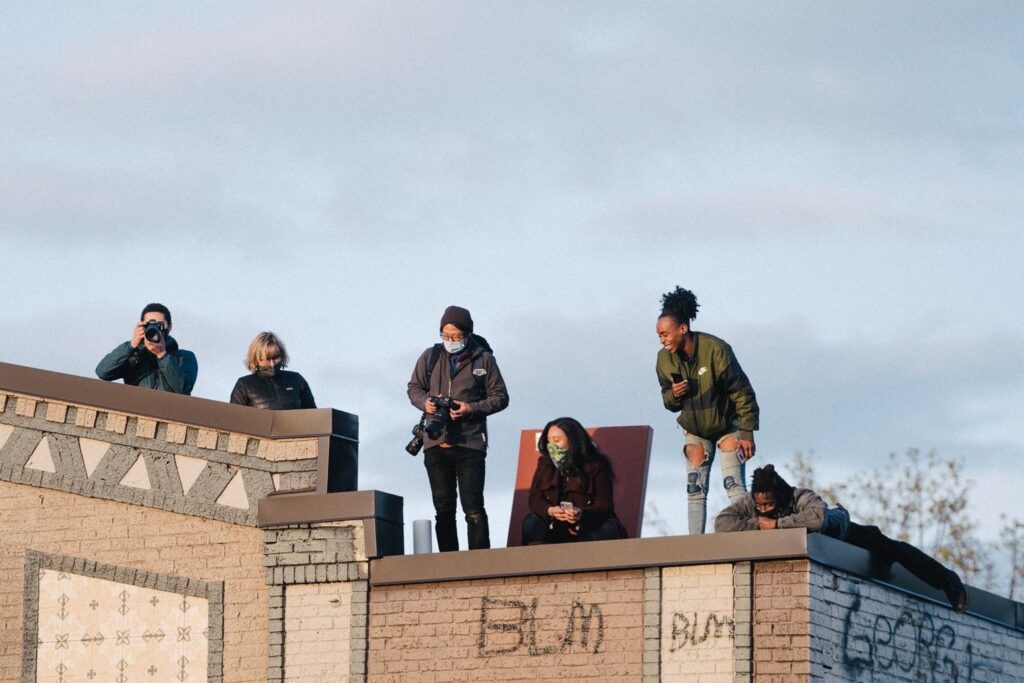During one of the protests on the 35W Bridge, I had a powerful moment. I saw the tanker on the other side of the highway coming down. Watching as protesters pulled the driver out, I thought about my ancestors walking with Martin Luther King across highways, from Selma to Montgomery — all of the emotions they felt, how they must have been terrified, seeking justice. I realized this was our civil rights movement, our part of the struggle. I thought, OK, I’m dedicating everything to this; being a public historian, telling people stories.
— Acoma Gaither
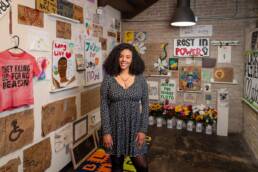
A Jamaican Black American in White Schools in Ohio
My parents are amazing people. My dad is originally from Chicago, and my mother’s family is from Jamaica, but she grew up in Ohio. I am Jamaican Black American. I spent my childhood in Toledo. I’m the only child. Not having a sibling to talk to about family drama, or just to live life with, was pretty lonely. As a child I was into sports — I played basketball and softball — and I also was into the arts, especially theater. I loved like being on stage and performing.
I went to predominantly white schools. It was challenging in terms of learning who I was as a young Black woman. In middle school, I transferred from my Toledo public school to Andrews Osborne Academy, an overnight school in Cleveland. My parents stayed in Toledo, so I didn’t see them often. I lived at school during the week and stayed with my grandparents in Cleveland on the weekend.
My parents moved to Minneapolis during my junior year of high school. For college they wanted me to move to Minneapolis. I was like OK, fine. I didn’t know what it was like in Minnesota; it seemed like the tundra. I didn’t know anyone from there. I was admitted into the University of Minnesota, but I was super intimidated by the Minneapolis campus — there had been 32 of us in my graduating high school class. I decided to go to a smaller campus.
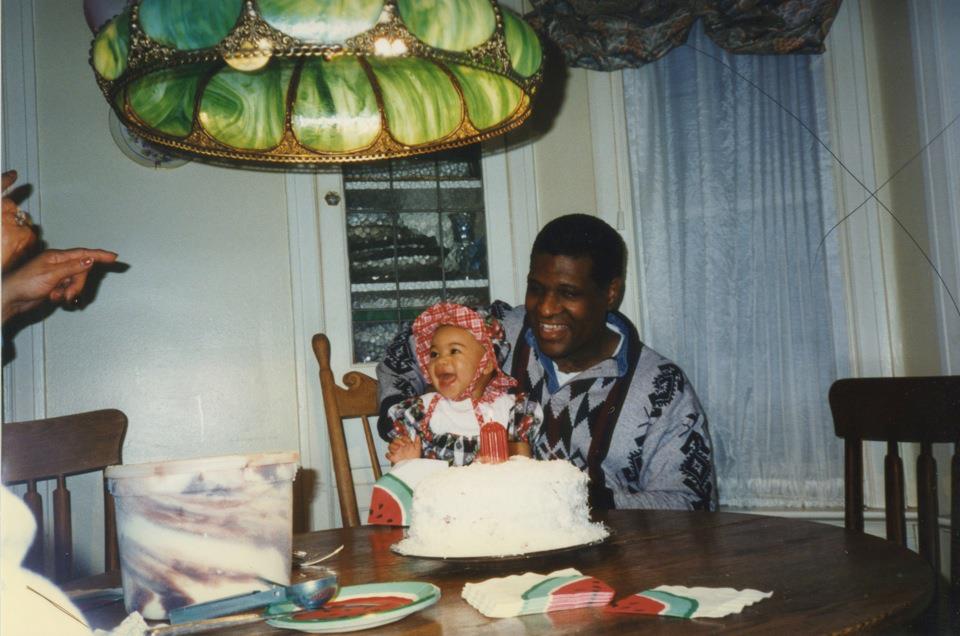
College in Morris, Minnesota
When I was eighteen, I moved from Cleveland, Ohio, to Morris, Minnesota, about 60 miles east of the South Dakota border. Coming from a small high school, I thought I was going to really like it. The campus had only about 1900 students. I swear I was one of five Black people in that whole section of Minnesota. I had gone to predominantly white schools all my life, but now I needed to figure out who I was. I was in theater at Morris, but I could not relate to any of the material we were working with. The people I was around—the things we were doing in class—I could not identify with any of it.
I moved to Minneapolis. I had this idea that I wanted to open up a nonprofit organization where I could do art with young people. I entered the Youth Studies Department within the School of Social Work at the U of M where I explored the role artists and arts organizations can play in building connections with people and their neighborhoods.
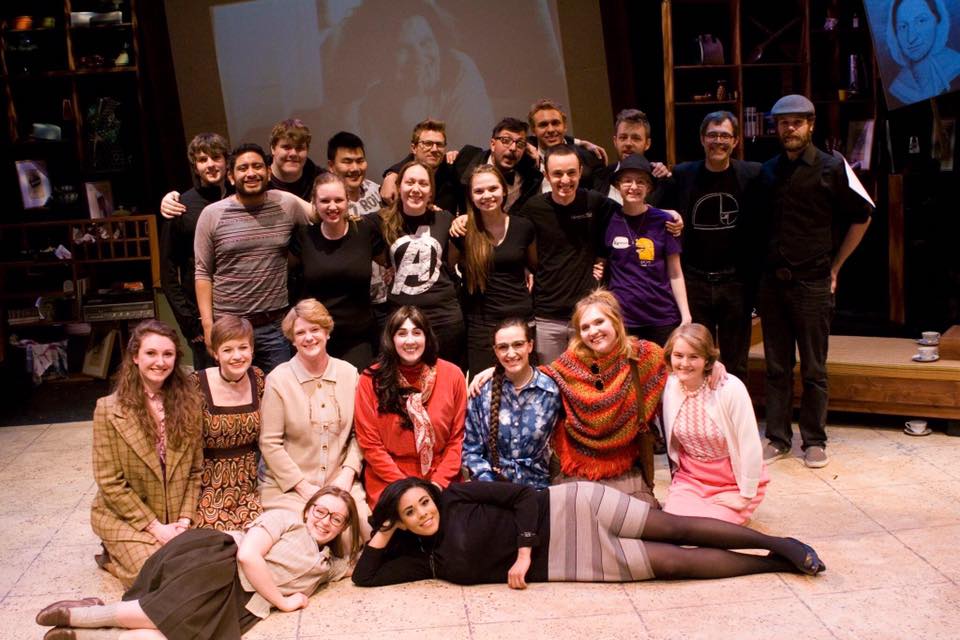
Youth Advocacy Work
During those years, I worked with young people in Twin City community centers. I was the youth coordinator at Pillsbury House Theater, and did art projects with first and fourth graders at Free Arts, through the Northside Childhood Development Center. At the McDonough Housing Community in Saint Paul, I was a mentor for young women. One day at McDonough I asked the girls what they wanted to be when they grew up. A lot of them wanted to be models or some sort of entertainer. That struck me. Nothing wrong with that, but I wanted them to get more exposure to what else is out there, all of the things that a young Black woman can be.
I also worked at Irreducible Grace Foundation with kids in the foster care system, teaching them ways to de-stress through theater. We would write monologues about situations, like a student getting into an argument with a teacher. I taught them breathing and movement techniques that send signals to your brain to calm down. That was really rewarding. All of these projects helped me learn about myself. Kids are so real.
My senior year, I decided to work with the Minnesota Historical Society (MNHS) and learn issues around underrepresentation of communities of color and American Indigenous Nations in museums. I did a fellowship with them, working on their teen programming, planning curriculum about Black history in Minnesota. Oh my gosh, that changed my whole perspective. I’ve always had a love of history. Throughout school, I was the one student doing Black history projects. I was into theater as well. Hearing and telling stories are my loves.
Becoming a Public Historian
The same time I was at MNHS, I was working at the Minnesota Children’s Museum, which was really cool. I loved the informal learning atmosphere of museums. I decided they were a place I could combine my love of storytelling, social justice and working with youth. I looked for way to pursue these interests.
History is seen as this academic elitist kind of field, which doesn’t make sense at all. It is storytelling. I was fortunate that just as I was looking, the University of Minnesota in partnership with MNHS, had just formed the Heritage Studies and Public History graduate program. I applied and got in. My graduate research has focused on telling the story of Black Minnesotans and site-specific community led public histories of mutual aid. As a public historian, I’m committed to transforming the field I’m trained in, positioning practices of history within the ongoing resistance movements against extractive dispossession and racial capitalism.
Fort Snelling at Bdote
The summer before my graduate program, I worked as an historic interpreter at Historic Fort Snelling, a unit of the Minnesota Historical Society. That was when some Republican Representatives in the Minnesota Senate threatened to take over administration of that heritage site because we added At Bdote to the site name. We didn’t even change the name, we just added the Dakota word for this sacred place where two waters — two rivers — come together.
The Republicans were like, “This is revisionist history, we’re going to cut your funding…“ They said we didn’t go through the process correctly. So the MNHS said, “We will roll back the process, interview the community and get inputs online.” When you make a decision and then go back on it that creates more pain. It was super difficult. There were protests outside of the site, and a lot of bigotry. The fort became a very contested space.
Aside from the naming issue, there was a kind of balancing act between the various stories about the Fort’s history, and points of view to include. This brought forth delicate conversations around narratives of colonialism, and, in particular, the framing of counter-narratives presented by Indigenous voices. Hundreds of Indigenous women, children, and elders were imprisoned at Fort Snelling during colonial encroachment. Yet military enactments continue at the fort, re-staging the historical violence of the colonial past, as well as valorizing a militarism that left thousands traumatized generationally and separated from their traditional homeland.
I understand that people are paying money to see those enactments. It’s a form of entertainment. As a child, I liked going to living history sites and getting engaged with actors and the interpreters playing those roles. I didn’t go to Monticello, however. I heard stories about that. But I did go to Sauder Village, and Ohio Village, that interpreted the lives of early settlers. Now I see how that was replicating violence, how reenactment history can be problematic.
Dred and Harriet Scott at the Minnesota Fort
I was one of two people of color at Fort Snelling. The other person was Dakota. I was there because the MNHS administration had been working on an initiative to talk more about Dred and Harriet Scott’s experience at the Fort. I would say those two individuals were the most important people that ever lived there. I was given the job of interpreting their story. It was heavy. I remember school groups where many people would say, “I don’t know if we should be talking about slavery with young folks.” I was like, are you kidding me? Children were more receptive and understanding than a lot of the adults. Kindergartners really got it. They knew that people shouldn’t own other people. I didn’t have to get into any arguments with them.
Finding Deficits in MN Black History Archives
During graduate school, I worked in the collections department at the Minnesota Historical Society to build up their Black history collection, which is not expansive. They didn’t have any contemporary Black history. There was hardly anything on Black Lives Matter and there wasn’t much on Black LGBTQ history. This experience showed me what is valued in terms of preservation; whose story will be there for future generations. I was really upset. How could you not include these stories?
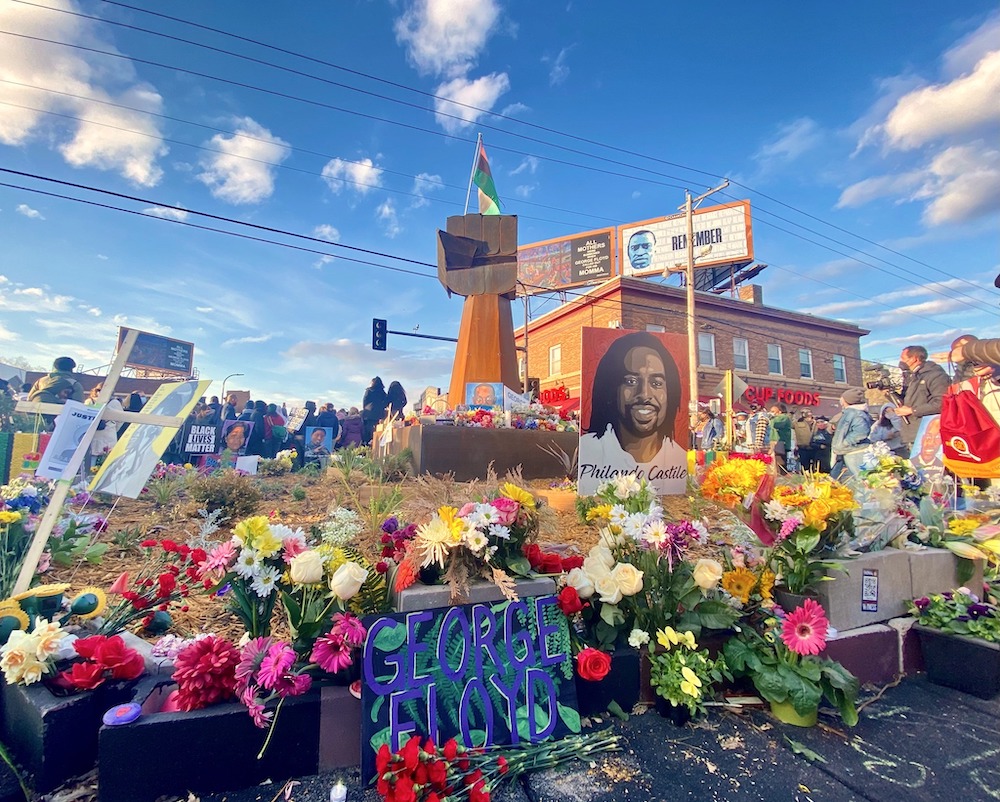
Documenting the Uprising of 2020 and Rise of Mutual Aid
Then the summer uprising of 2020 happened. Being in public history, I decided to start documenting everything that was happening. I was amazed at the fact that this happened here. I was amazed, but then I wasn’t, because I had done the research for the race and policing exhibition.
What blew my mind was how global the movement became.
The pandemic was raging. Who was disproportionately affected? People of color. No surprise there, but I was amazed at all of these mutual aid efforts that grew out of coping with the pandemic and the uprising. I started interviewing protesters and taking photographs along Lake Street where the businesses had been burned down, just trying to document and save stories. I did some oral history interviews.
History For the Future
My classmate Andrea Manolov and I are the co-creative directors of a local public history project called History Through the Future, which explores the past and present efforts at mutual aid. We decided to do this as part of our capstone project. We put on a series of public events using art, community dialogue and the archives that we found. This project feels like the fruition of everything I have done so far in my life.
We are putting on six forums and a final exhibition that takes all of the collective information from these programs, as well as site-specific research on mutual aid, and puts it into an outdoor exploration. It will open June 4, in the open lot next to Moon Palace Books, three buildings down from where the 3rd precinct was burned down.
Hearing people’s stories and learning how they’re engaging with their community felt like something that you read about in history books. You don’t think you will experience it in your body and witness it all around you. My parents told me, “We didn’t even witness this back when we were growing up.”
A Life Changing Moment During the Minneapolis Uprising of 2020
During one of the protests on the 35 W bridge, I had a powerful moment. Everybody was kneeling down with their fists up, silent for a minute. I was in the back where I could see most of the crowd and the entire Minneapolis skyline. I felt in community with everyone. Suddenly I heard shouts and screams coming from ahead. A wave of people started running and falling on top of each other.
I had my bike and I thought, OK, I’m just going to stand here. I’m not going to push over anybody. I want everybody to run to safety. Friends I had been with, were gone. It was then I saw the tanker on the other side of the highway coming down. Somebody was on top of it. People were hanging off the sides. I watched as protesters pulled the driver out.
I started to think about my ancestors walking with Martin Luther King across highways, from Selma to Montgomery. All of the emotions they felt, how they must have been terrified, seeking justice. I realized this was our civil rights movement; our part of the struggle. It is always this endless struggle, and this is our part. I thought, OK I’m dedicating everything to this; being a public historian, telling people stories. Preserving our heritage is so important for future generations, letting people know how people survived, how communities came together and fought. That is when I decided to focus my energy on mutual aid. That was summer and fall 2020.
Preservation of George Floyd Memorial Artifacts
In the winter and spring of 2021, I got the opportunity to do a Preservation and Protest Fellowship in Collections Care, working with conservators with the Midwest Art Conservation Center and Jeanelle Austin of the George Floyd Memorial, to catalog and inventory all of the protest signs and artworks that had been left as offerings at George Floyd Square.
There I was again, working at Pillsbury House. They are a few blocks down from George Floyd Square, and they offered a classroom for the preservation project. I went there Tuesday through Friday, nine to five, cataloging, surface-cleaning and taking photos of items left at the memorial, 2200 pieces and growing every day. These offerings were laying outside and they have been through the elements. One piece that had been washed out by rain has only one word still visible: “breath.” There’s a lot of children’s artwork. It was just so sad that children had to process this event.
We had our first pop-up exhibition at the memorial, to display the offerings. When an exhibition goes up in a museum it usually takes a year of planning. This was two weeks. We were working so hard! We wanted to use a larger gallery across the street, but the owner was charging way too much. So we are exhibiting a little more than two hundred of the offerings in the lobby of the Chicago Fire Art Center. It’s a small space. We used up every single wall. It opened on March 21st and will close June 19th.
I think the exhibit got community excited again and made the memorial more permanent. It offered us a re-memory of the uprising. It’s been hard because the narrative around the space hasn’t been good from the Minneapolis City Council and the Chief of Police. While some people locally were scared to come, we’ve had people from all over the country visit the exhibit. When I was there, I met families from Florida, Chicago, Wisconsin, and California.
Being in that exhibit space while listening to the Derek Chauvin trial on the radio was so powerful. Angela Harrelson, George Floyd’s aunt, came. Right afterward, she made a video talking about her gratitude at the fact that people took so much care and love in creating this exhibit. That was a lot. I thought, this is why I do what I do. The exhibit is heavy, but there’s a lot of energy in that space too.
Soul Food Monologues
In April of 2021, I worked with LaDonna Redmond who runs the production organization Soul Food Monologues. We were doing intense weekend workshops five hours a day, Friday through Sunday, with food justice activists, some of whom are doing food distribution at George Floyd Square and at protests. I participated in all-day writing workshops and wrote a monologue on food justice, talking about how George Floyd was buying groceries and was killed right outside a grocery store. Eric Garner was also killed outside of a convenience store. My main takeaways were talking about how food is connected to our ancestors, and can be a conduit of sharing love and building community.
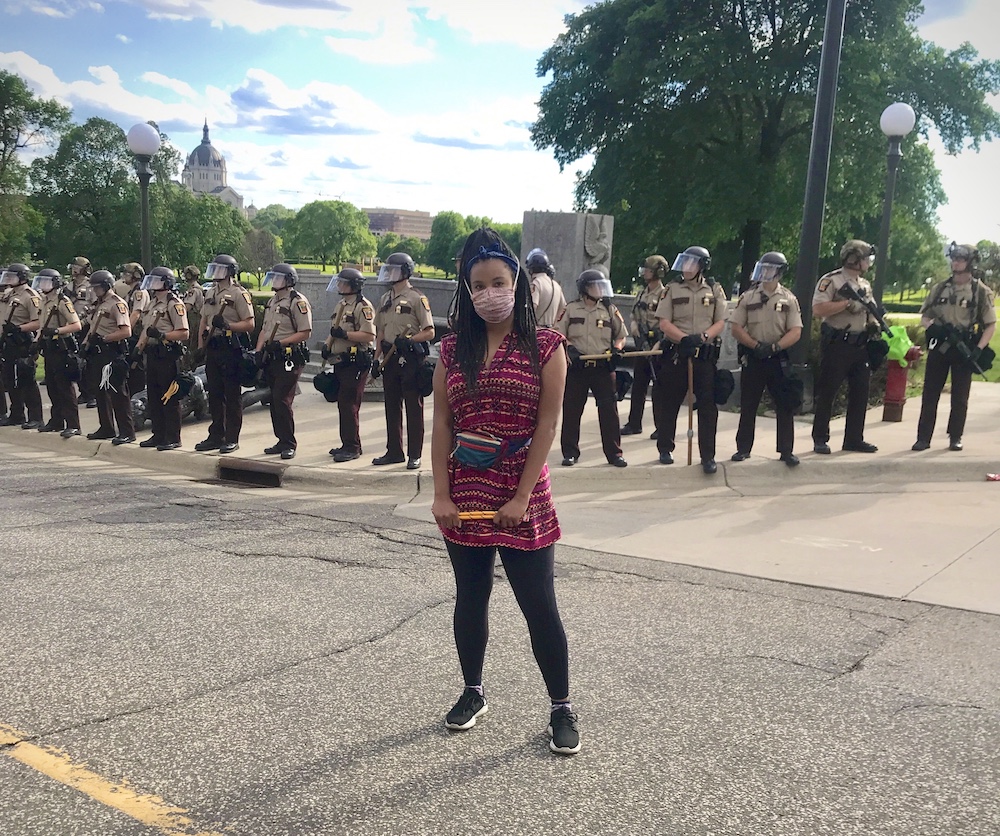
History in Real Time: The murder of Daunte Wright during the Chauvin Trial
On April 12th, I was going to perform in a Soul Food Monologue, but we canceled the performance when we heard that a 20-year-old had been shot by a woman police officer in Brooklyn Center. We heard she yelled “taser” but pulled out her gun. This was in the middle of the high-profile Derek Chauvin trial. The trauma and hurt in the Black community in Minnesota was so raw: Black life on trial and then we have another shooting.
I was outraged. On April 11, Nekima Levy Armstrong went on Facebook Live, saying that there’s tear gas and rubber bullets being shot at protesters right outside of the Brooklyn Center Police Department. My body was telling me, you really need to be there. I took a friend with me who was visiting from Toledo. He had never been to a Minneapolis protest against police brutality. It was shocking for him.
I don’t trust a lot of mainstream media. I rely on alternative news networks to figure out what people are witnessing. When I was there, I saw tear gas, which is banned in war, but ironically legal for use domestically by law enforcement. The fact that they will do that on their own citizens is mind boggling to me. I saw somebody that had their hand shattered by a rubber bullet.
I also saw mutual aid. Street medics were out there. There were designated spots where people could get aid, including granola bars, water, milk for the tear gas, and bandages.
I was there from about 10:00 PM to around midnight. The National Guard was called out and they issued a curfew. I was a few feet from my car when I saw this police line with a truck behind them, trying to arrest people. They were so close to us, but, my friend and I were able to get in the car and leave. We went to the gas station right down the street, near the police department, to decompress. My friend said, “I have never witnessed something like this.”
I told him, “This is what happened last summer.”
We didn’t know that night that Chauvin would be convicted.
Next Step: Smithsonian Black History Collection
This is a time of big transitions for me. The George Floyd Fellowship ended May 1st. I graduated from the U on May 12. I’m still doing my mutual aid programming, building that exhibition out. My next project is to work with the Smithsonian National Museum of American History on a project with their African American history collection. I will go out to DC for a week to do an assessment of the collections. Then the work will be virtual until they re-open.
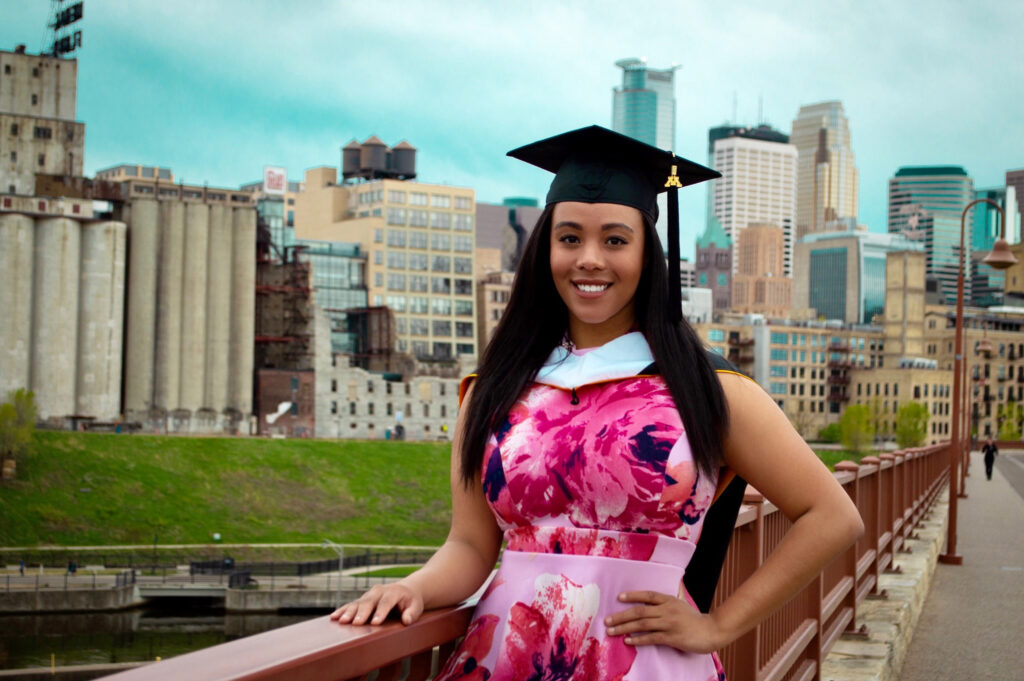
Be a Witness to Truth-telling
I hope everyone reading this will come to our Mutual Aid exhibit History Through the Future, June 4, and the George Floyd Memorial exhibit, still up at the Chicago Fire Art Center until June 19. In one piece, you will see how a child drew out the moment that George Floyd passed. Their drawing shows the entire scene, the officers, the bystanders on the street. The title of it is Take your Knee Off our Neck.
